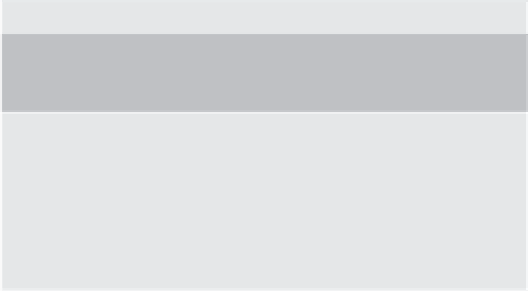Biomedical Engineering Reference
In-Depth Information
studied in the treatment of male and female pattern hair loss
and in skin rejuvenation (15-17). The 1540-nm and 1340-nm
fractional lasers are available through the DEKA Dot platform
(DEKA laser, Firenze, Italy). In the USA, there is a also a frac-
tional 910-nm laser by Syneron Medical Ltd. and a fractional
Q-Switched 1064 nm by Alma Lasers. Prototypes of a frac-
tional 1940-nm and a 1208 nm laser have also been studied.
Table 8.4
Starlux 1540-nm Laser Treatment Settings
Superfi cial/
Moderate
Corrections
Deep
Corrections
Handpiece (mm) 15 10
Millijoules per microbeam 6-15 25-50
Pulse width (ms) 5-10 5-10
Passes (20-50% overlap) 2-5 2-4
Number of treatments 3-5 3-5
Treatment intervals (wk) 3-4 3-4
Source
: Adapted from Palomar Laser Systems Operator Manual.
clinical considerations
Before initiating an NAFL treatment series, several clinical
considerations need to be carefully examined. Specifi cally, the
treating physician and support staff should carefully consult
with each patient about the indications for treatment and
expected results of treatment, and review the treatment pro-
cess in detail.
Also, a medical history and physical examination must be
performed to identify contraindications for or impediments to
treatment. Patient selection for NAFL resurfacing is very
important. The ideal candidate has mild to moderate skin
damage or discoloration. Those with severely damaged skin
with deep acne scars/wrinkles or extreme laxity will benefi t
more from an ablative fractional/fully ablative or surgical pro-
cedure. Patients must also be counseled to have realistic expec-
tation of the treatment results. NAFL resurfacing yields slow
gradual improvement over a series of treatments. Fine lines
and scars do decrease but they are not completely removed.
Defi nitive improvement in brown pigmentation and actinic
keratoses can be seen but patients must be counseled that they
may recur with continued sun exposure and time. Daily sun
protection is necessary for all patients after treatment. Also,
the fi nal results from treatment may take 3-6 months after the
last treatment. This time is necessary to achieve the full effect
of collagen remodeling from the NAFL. During the consulta-
tion, the treatment experience is also discussed in detail.
Patients are instructed that a series of treatments will be neces-
sary. Usually, the treatment can be accomplished over 2-5 ses-
sions spaced 4-6 weeks apart, depending on the clinical
indication. Topical anesthetic will be applied to the treatment
area for approximately 60 minutes before the laser treatment
and the treatment itself will take 20-40 minutes depending on
surface area treated. Cool air and cold ice rollers can be used to
increase comfort during the treatment. A prickly heat sensa-
tion or a zap of heat can be felt on the skin depending on
which NAFL system is used during the treatment. After treat-
ment, patients may feel like they have a sun burn. Redness and
swelling should be expected initially. Skin dryness with a fl aky
dot appearance can last a few days up to 2 weeks depending on
the intensity of the problem and the body area treated. During
the consultation, side effects are discussed, a medical history is
reviewed, and physical examination of the treatment area is
performed. Contraindications include oral retinoid use within
the last 6 months, predisposition to keloid formation or exces-
sive scarring, and lesions that appear to be suspicious for
malignancy in the treatment area. Recent sun exposure or
tanned skin, pregnancy, an active infection in the treatment
area, or a medical condition that compromises healing time or
predisposes to infection also can be added to the list. History of
herpes simplex virus infection is a mandatory portion of the
medical history as reactivation of the virus can occur with
NAFL treatment. Pretreatment with an oral antiviral is
Table 8.5
Icon 1540-nm Laser Treatment Settings
15-mm
tip
10-mm
tip
XD
Microlens
XF
Microlens
Millijoules per
microbeam
10-15
40-70
40-70
30-50
Pulse width (ms)
10-15
10-15
15
10-15
Number of
passes (20-50%
overlap)
3-4
3-6
3-6
1-2
Number of
treatments
2-5
2-5
2-5
1-2
Treatment
interval
3-4 wk
3-4 wk
3-4 wk
1-3 mo
Source
: Adapted from Palomar Laser Systems Operator Manual.
the multi-wavelength fractional
1440-
laser
The Affi rm™ Multiplex laser (Cynosure Inc.) is a fractional
laser the emits a combination of 1440-nm and 1320-nm wave-
lengths of Nd:YAG laser. The Multiplex technology is defi ned
as the sequential emission of two laser wavelengths using one
laser fi ber. It has a diffractive lens array that consists of 1000
diffractive elements per cm
2
to affect more surface area per
single pulse. The laser uses combined apex pulse (CAP) tech-
nology. CAP technology reportedly delivers apex pulses of
high-fl uence regions for collagen remodeling and low-fl uence
regions to stimulate collagen growth. The 1440-nm wave-
length heats a column of tissue to a depth of 300 µm and the
1320-nm wavelength penetrates deeper (12). Cynosure's Smart
Cool™ air cooling system van be attached to the handpiece to
protect and cool the skin. Usually, topical anesthesia is not nec-
essary. A 14-mm spot size is used; usually two passes are sug-
gested with a 15-20% overlap. Four to six treatments spaced
3-6 weeks apart are necessary for improvement in superfi cial
scars and photodamage. The 1440-nm laser has a maximum
energy of 8 J and the 1320-nm laser has a maximum energy of
14 J. Typical treatment parameters for skin rejuvenation would
be 2-3 J/cm
2
for the 1440-nm component and 6-10 J/cm
2
for
the 1320-nm component (13).
nm
⁄ 1320-
nm
other fractional lasers
A fractional Q-switched ruby laser (TattooStar FRx, Asclepion,
Jena, Germany) has been reported to improve melasma in
Korean patients (14). A 1540-nm fractional erbium glass laser
(Mosaic, Lutronic Co. Ltd, Seoul, South Korea) has been




















